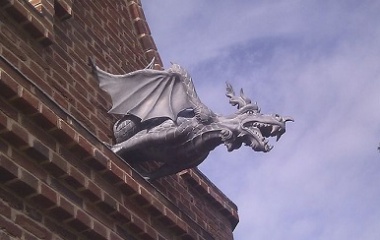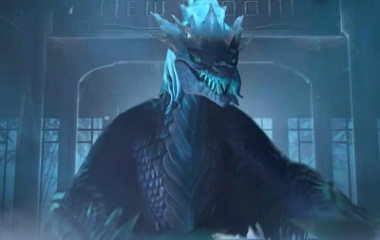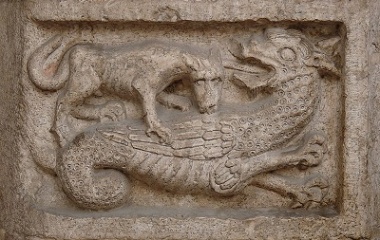What is a Wyvern?
A Wyvern is a small, dragon-like creature (sometimes called a dragonet), which mimics a dragon’s powers and habits on a smaller scale. Although they aren’t as ferocious as their larger cousins, they are highly aggressive and more than capable of killing an unarmed traveler or damaging an unprotected town.
Characteristics
Physical Description
The physical resemblance between Wyverns and dragons has led many people to believe that these creatures come from the same family. That may be true, but they are still very different species with important physical differences.
First and foremost, Wyverns have two legs, whereas dragons have four (or in some ancient descriptions, none). The smaller serpent’s legs are also more birdlike—long and spindly, with widespread toes and sharply curved talons—where a dragon’s legs are reptilian. Not only do their legs give them a unique look, they also give them a unique style of movement, hopping, hovering, and pouncing instead of crawling.
Second, the Wyverns’ tails have a unique barbed end. Some texts claim that this barb is actually a stinger that can deliver a painful dose of poison, which would give them one weapon in their arsenal that dragons don’t have! Other texts describe dragonets who have adapted to semi-aquatic life by developing a more fish-like tail.
Special Abilities
Wyverns share many of the same abilities as dragons. They are outstanding flyers, and they can often be seen circling high in the sky as they scout out treasure to plunder. When they manage to make off with a new trinket, they carry it to their lairs, where they horde their “treasure.” Their hordes, however, are not nearly as impressive as true dragon hordes, which have been known to make men sick with greedy and envy. Comically, the little dragonets will collect anything shiny, even if it is nothing more than a cheap spoon.
They are fearless fighters, even more so than their calculating cousins, who usually only fight when the odds are in their favor. Wyverns will plunge into battle with any enemy, regardless of how powerful he looks.
Whether or not the little serpents can breathe fire is hotly debated. Certainly, they don’t contain an inexhaustible supply of fire, like the mighty dragon does, but some texts do describe Wyverns spouting small balls of flame at their enemies or onto a straw roof. They have even been nicknamed “fire-drakes” in some Medieval bestiaries.
The Wyverns deadliest weapon of all is their breath. Even if they can’t breathe fire, they can breathe something far more dangerous: pestilence. They spread contagious disease wherever they go, and during Europe’s dark ages, they were blamed for spreading the Black Plague, a grotesque disease that claimed millions of lives.
Cultural Representation
Origin
Although the first depiction of a Wyvern has been lost to history, it is clear from bestiaries and alchemy texts that these little dragons were well-known throughout Europe as early as the medieval period, in the fifth century AD.
Some scholars have speculated that the Wyvern may have sprung from Roman war banners, which would have been seen by the early Europeans when Rome’s conquering forces began to spread north. This idea is supported by the fact that the etymology of the word “wyvern” can be traced back, through French, to the Latin word “vipera,” which would have been used by Romans.
Heraldry
Wyverns are believed to have appeared on English war banners as early as the eighth century, when Wales was represented by a “red dragon” and Wessex by a “gold dragon.” By the sixteenth century, the popularity of this little dragon as a symbol of courage and strength had earned him a place on the coat of arms of many prominent families in Wales and Wessex. By the nineteenth century, English companies nationwide had begun to use the dragonet as their logo, and today, he can be found as a logo or mascot around the world.
Video Games
Outside of heraldry, the Wyverns largest territory is the realm of video games. With their formidable shapes and ferocious attitudes, these monsters make an ideal villain for fantasy games, and they have claimed many a player’s life in bestselling games like Final Fantasy, World of Warcraft, and Dragonlance.
Some of these games have incorrectly called their Wyverns “dragons,” despite the fact that the monsters only have two legs. Luckily, mythological purists have taken to the internet in droves to set the record straight for any players who are curious to learn more about the games’ characters.











” I am a huge fan of wyverns and think that this website has some invalid information, first of all the wyvern has never had a poisonous tail ( assuming were talking about the common fire wyvern) it does have a pointed tip though and there are many different kinds of wyverns like fire, ice, thunder, and venom( just to name a few ).
“Some of these games have incorrectly called their Wyverns “dragons,” despite the fact that the monsters only have two legs. Luckily, mythological purists have taken to the internet in droves to set the record straight for any players who are curious to learn more about the games’ characters.”
These people are the most obnoxious and idiotic annoyances on the internet, and this section from the wikipedia article on Wyvern explains why:
“Wyverns are very similar to dragons, and in many languages, cultures and contexts no clear distinction is made between the two (both words not existing in most cultures until modern times). Since the sixteenth century, in English, Scottish, and Irish heraldry, the key difference has been that a wyvern has two legs, whereas a dragon has four. However, this distinction is not commonly observed in the heraldry of other European countries, where two-legged dragon like creatures being called dragons is entirely acceptable”
what friends and foes do wyverns have
wyverns only eat goats
you should add werewolves
bruh